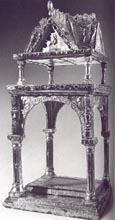

Ciborium of King Arnulf. Munich, Schatzkammer der Residenz.
excerpt from J. Hubert, J. Porcher, and W.F. Volbach, The Carolingian Renaissance, New York, 1970: p. 256: The three finest pieces of goldsmiths' work that have survived from the Palace School of Charles the Bald are the second cover of the Lindau Gospels, now in the Pierpont Morgan Library, New York, the portable altar (ciborium) of King Arnulf, and the cover of the St. Emmeram Gospels in Munich.... Since the manuscript of St. Emmeram was penned by the brothers Berenger and Liuthard for the king in 870 and since the style of the reliefs relate them very closely to the miniatures within, we may infer that the metalwork was executed at the same time....
In about 896 the Gospel Book was presented by King Odo or Charles the Simple to King Arnulf, who sent it together with the ciborium to the monastery of St Emmeram at Regensburg. It was restored there under Abbot Ramwold (975-1001). In the centre Christ is seated on a throne surrounded by the four Evangelists. In the corners are represented the woman taken in adultery, the money changers driven from the temple, the healing of the leper and the blind man restored to sight....
Despite a few minor differences in the style of the reliefs, the ciborium of King Arnulf in Munich is very closely related to the second Lindau cover and still more to the St. Emmeram Gospels. The ciborium and the Gospels have the same history. On the base of the form is an inscription naming King Arnulf as the donor. On the four tympana are the Hand of God, the Lamb, the Angel, and the Globe; on the sloping sides of the roof, scenes from the New Testament: the Temptation of Christ, the raising of Lazarus, the parable of the lilies of the field , the calling of Peter, and the resurrection of the young man of Nain.
Excerpts from C.R. Dodwell, Painting in Europe 800-1200: p. 69: When St Wolkkang, Bishop of Regensburg, wished to reform the house of St Emmeram in his diocese, he had turned not to Einsieldeln, where he himself had been prior, but to St. Maximin at Trier. From it he brought Ramwold, who ruled over St Emmeram as abbot from 974 to 1001....
The Carolingian influences derive from the Gospel Book of Charles the Bald which was brought from France by the emepror Arnulf and given to St Emmeram in the ninth century....
p. 70: [Gospel Book of Uta (Munich, Staatsbibliothek cod. lat. 13601) Crucifixion:] Christ is here seen on the Cross as the victor, wearing the stole of eternal life. Incidents depicted on the right typify His victory over death, others on the left represent the new resurrection of life. Inscriptions clarify all this symbolism and extend its significance, indicating, for example, the necessity of the Cross to Salvation and the relation of God's rule both to human knowledge of proportions and to the harmony of the spheres, and comparing the length and breadth of the Cross to charity and perserverance. All this reflects the development of scholarship which accompanied reform at Regensburg and which now gives a new intellectual depth to painting.... At Regensburg...the commentary becomes an integral part of the picture, symbolism is given a new intellectual content....
Carl Nordenfalk, Early Medieval Painting, p. 213: [Description of St. Erhard Celebrating Mass from the Uta Codex] The figurative scenes are distributed in several parts of the composition. We are shown Uta, Domna Abbatissa, seated in the upper righthand corner, and in the other corners women symbolizing the various religious virtues. Uta is gazing in adoration at the Lamb of God, the mystical bridegroom who is indicating a text of the Bible written in the open book before him. In the central scene St. Erhard, clad in the robes of a high priest of the Old Covenant, is celebrating the divine rite, making use of the gifts donated to the convent of St Emmeram....From the fragments of text included in the composition we learn that it is an allegory of the triads of the ecclesiastical hierarchy as described by pseudo-Dionysius the Areopagite in the Latin translation of Joannes Scotus. Thus 1) the sacred objects used in the celebration of the Mass, 2) the officiating priest and 3) his deacon symbolize three degrees of access to the godhead. On the opposite page is Christ on the Cross, depicted both in priestly raiment and as a king wearing a crown. The four successive phases of the Redemption, as revealed in Holy Writ, from Adam's sin to the divine expiation, are likened, by means of verses and schemata, to the four basic figures of geometry, the four elements of of music, and so forth....